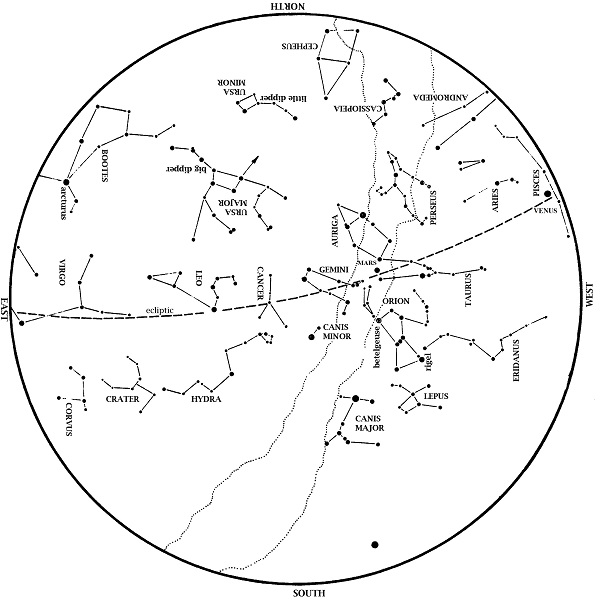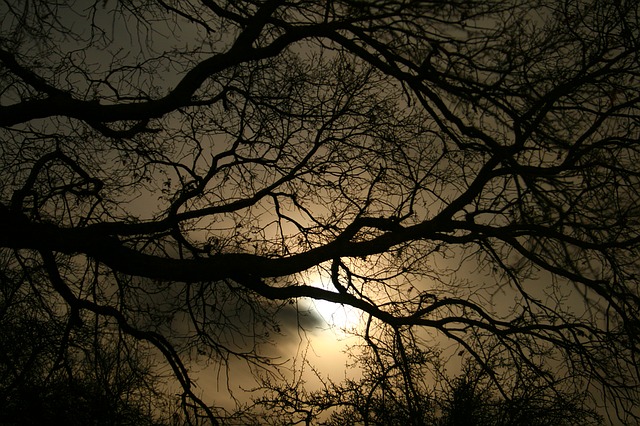
This star map shows the Houston sky at 9 p.m. CST on Feb. 1, 8 p.m. CST on Feb. 14, and 7 p.m. on Feb. 28. To use the map, put the direction you are facing at the bottom. The Great Square of Pegasus sets in the western sky. Taurus, the Bull, is almost overhead. Dazzling Orion, the Hunter is high in the south, with his two dogs behind him. Sirius, the Big Dog Star, is the brightest star we ever see at night. Jupiter, in Gemini, approaches the zenith on February evenings. Look for Canopus, the second brightest star ever seen at night, low in the south.
This month, Venus has entered the morning sky. Look southeast at dawn for the brightest point of light there; only the Sun and Moon outshine Venus. Venus remains a morning star for almost all of 2014.
Jupiter, up literally all night long last month, remains well placed for evening observing all winter and spring. Look for it in the east at dusk and almost overhead later in the evening.
Mars remains in the morning sky. It continues to brighten a bit in the south at dawn.
Saturn remains in the pre-dawn sky. Face south-southeast right before sunup to see it.
In February, the Big Dipper only partly risen at dusk. Its two pointer stars — the stars farthest from the handle which point at the North Star —may be high enough to see over trees and buildings.
Watch the Great Square of Pegasus set in the west at dusk. Taurus the Bull is high in the south. Look for the Pleiades star cluster above reddish Aldebaran. Dazzling Orion the Hunter takes center stage on winter evenings. Surrounding Orion are the brilliant stars of winter. Orion’s belt points down to Sirius, the Dog Star, which outshines all other stars we ever see at night. The Little Dog Star, Procyon, rises with Sirius and is level with Orion’s shoulder as they swing towards the south. To the upper left of Orion’s shoulder is Gemini, the Twins, which contains Jupiter this winter.
Under Sirius and low to the southern horizon this month is a star that most Americans never get to see: Canopus. Representing the bottom (keel) of the legendary ship Argo, Canopus is the second brightest star ever visible at night (second to Sirius). Thus, it is clearly noticeable along the southern horizon on February and March evenings. However, you must be south of 37 degrees north for Canopus to rise. (This is the line that divides Utah, Colorado, and Kansas from Arizona, New Mexico, and Oklahoma.)
The sky we see depends on our latitude as well as on the time of night and time of year. From any given location in our hemisphere, there is an area of the sky around the North Star in which stars never set (circumpolar stars), and an equivalent area around the South Celestial Pole in which stars never rise. The closer you are to the pole, the larger these areas are. Observers in Canada, for example, have many circumpolar stars, but there is also a large area of stars that they never see. The closer you get to the equator, the fewer circumpolar stars there are, but there are also fewer stars that never rise for you. At the equator, no stars are either circumpolar or never visible; all of them rise and set as Earth turns.
That’s why, down here in south Texas, the Big Dipper sets, although it’s always up for most Americans. On the other hand, Canopus, too far south to rise for most Americans, rises here.
1st Quarter: Feb. 6, 1:21 pm
Full: Feb. 14, 5:54 pm
Last Quarter: Feb. 22, 11:16 am
New: Mar. 1, 2:02 am
The Moon takes 27.34 days to orbit Earth; one cycle of Moon phases lasts 29.54 days. At 28 days long, February is the only month shorter than a lunar phase cycle, and thus the only month that can have only three of the four main phases. That’s the case this year, as a New Moon occurred at the end of January and the next comes early on March 1.
On most clear Saturday nights at the George Observatory, you can hear me do live star tours on the observation deck with a green laser pointer. If you’re there, listen for my announcement.
Clear skies to you!







